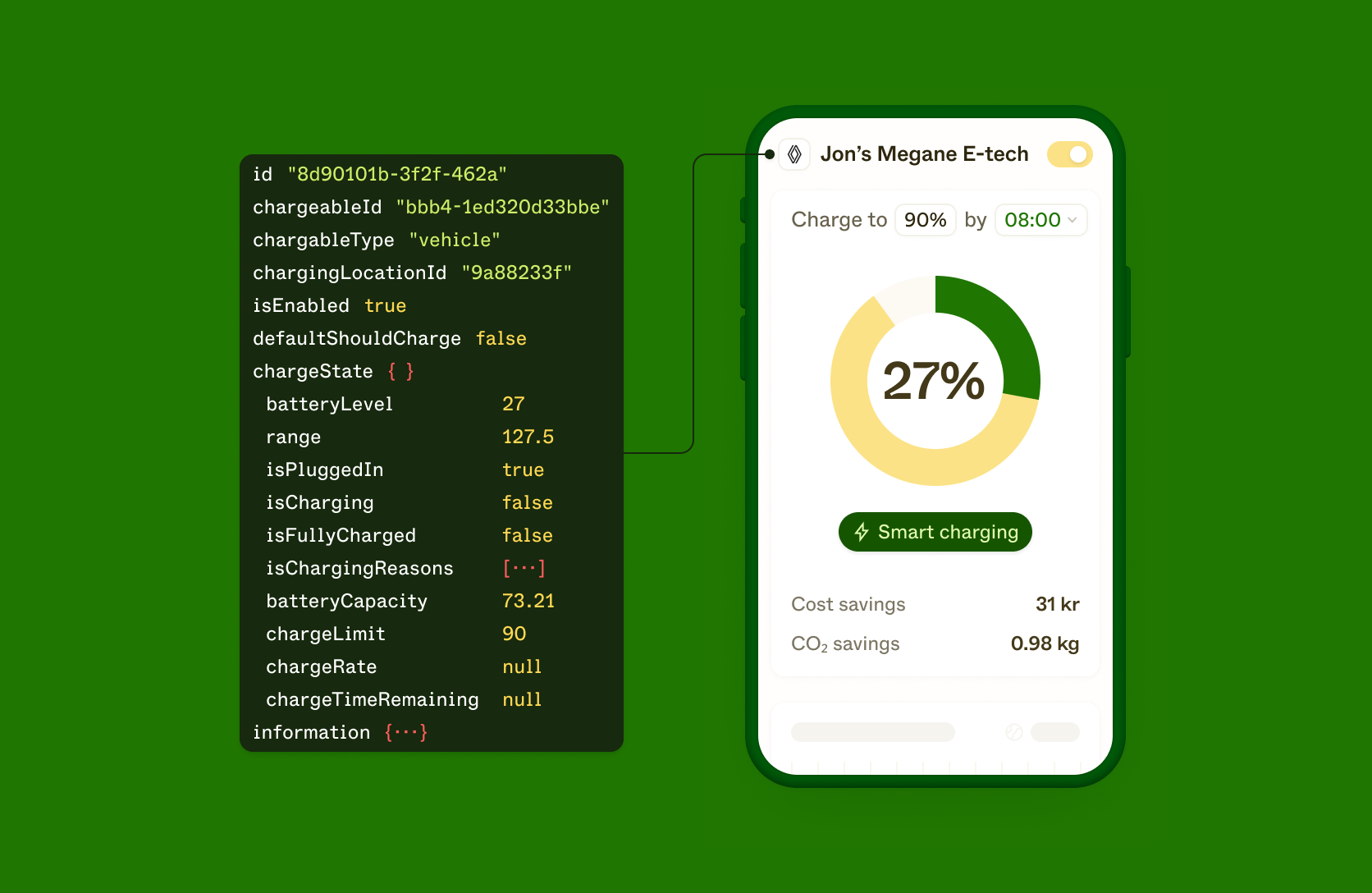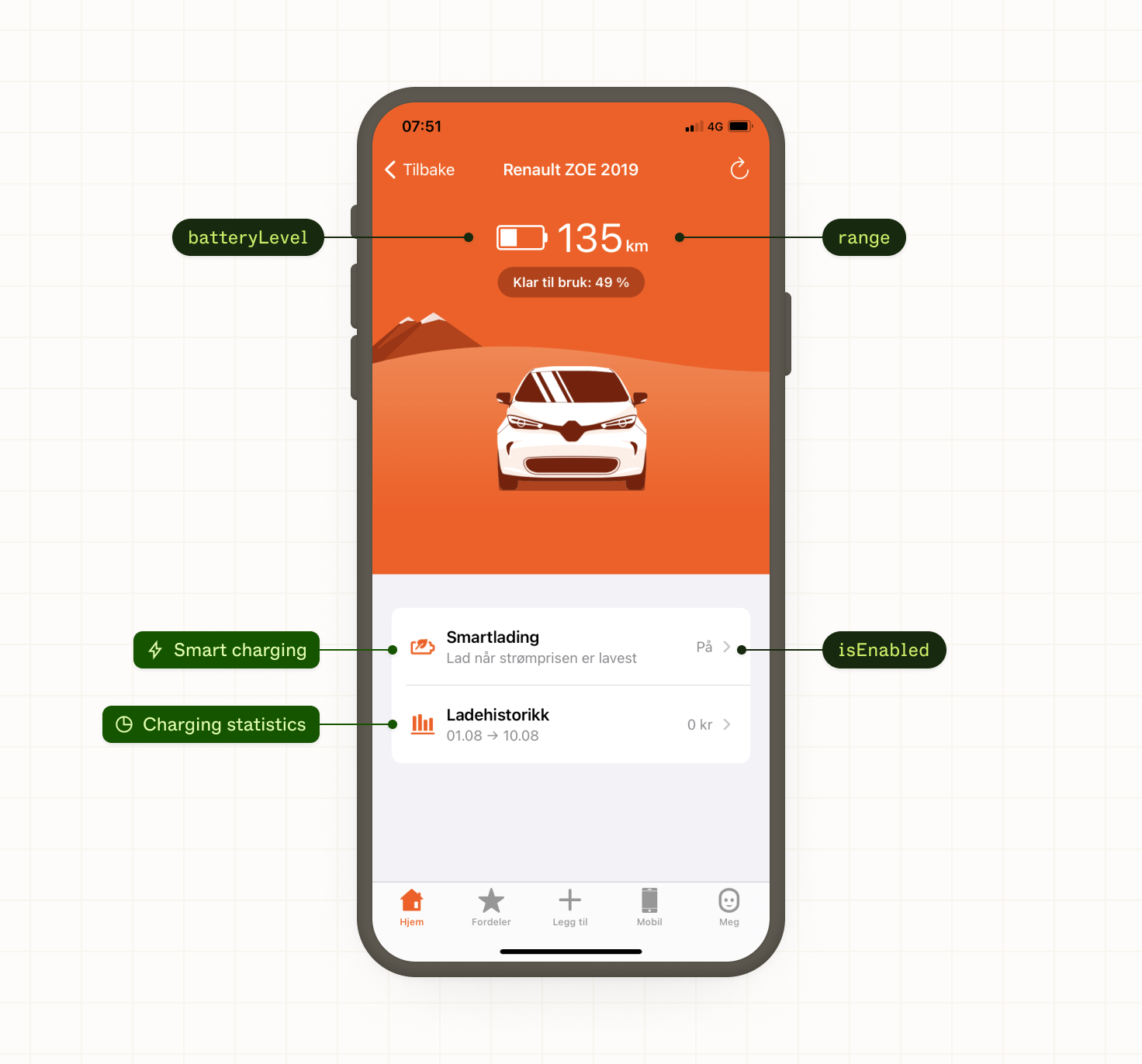The ultimate guide to electric vehicle (EV) smart charging

The number of EVs is expected to double every year for the next 5-10 years, resulting in over 100 million battery-electric vehicles on the roads by 2030. This massive increase in the demand for electricity leads to some fundamental challenges for the grid and our energy system as a whole.
At the same time, it gives us an opportunity to create a better and more flexible energy system. A system where every EV on the road is part of a large virtual power plant that increases the use of renewable energy and automatically balances the grid in real-time.
To make this happen we need to have most, if not all, EVs smart charging every night. So clearly this Smart charging things is key part of our sustainable future. But what it is? That is exactly what we will cover in this guide, so buckle up!
In this guide we will go through:
- What is Smart charging for electric vehicles?
- What are the benefits of smart EV charging?
- How can I smart charge my EV?
- How can I build a smart charging app?
- How to turn EVs into Virtual Power Plants with Smart charging
- Where to learn more about EV smart charging
What is Smart charging for electric vehicles?
Smart charging for electric vehicles means delaying the charging to a more optimal time. This could be a time when energy prices are lower or the share of renewable energy is higher. Smart charging is typically set up to be complete by e.g. 7am the next day, so it doesn’t affect the car owner.
But here we jumped into the details too fast. Rewind. To start off, what is smart charging? Well, obviously it is not regular charging. so let's start by defining that.
Regular charging means that when you plug in your EV it starts charging right away, at the maximum available charge rate, until it has reached the desired charge level. This can take anything from 1-10+ hours, depending on the charge rate, battery size, current charge level, temperature, and a few other factors.
Let's say the average charge time is 4 hours for an EV that is used for a daily commute. The owner comes home around 5 pm and plugs in the car, meaning it will be fully charged by 9pm. But, and this is the important part, most people don't need their car fully charged until perhaps 7am the next day. Meaning there is flexibility here, where these 4 hours of charging could actually occur at say 12am-4am, or any other time during that night.
And this is what smart charging is: moving those 4 hours of charging to the optimal time, while still making sure that the EV owner wakes up with a fully charged vehicle. Optimal in what sense, you say? Let's go one step further!
What are the benefits of smart EV charging?
Moving those 4 hours of charging to the night just for the sake of it is not smart. Smart charging is called smart for a reason. The cool thing with smart charging is that it can have a lot of positive impact on different stakeholders, all the same time even. Let's look at the three most important reasons why smart charging is…well, smart.
Lower energy bills for consumers
Smart charging lets consumer automatically charge their EV when energy prices are low. This is especially relevant for consumers on a time-of-use tariff, or an hourly spot price rate based on wholesale prices which is normal in deregulated energy markets.
The car owner on their end just plugs in like normal, and the car will pause charging and wait for those cheap hours to start charging again. The next day, without any input from the owner, the car is fully charged and the energy bill could be 20-100$ lower than with regular charging. Win!

More renewable energy
Another great thing about smart charging is that it can increase the share of renewable energy that we use. In the afternoon when a lot of people come home from work the total energy consumption is usually at a peak. As there is not always enough renewable energy available, power plants using coal or gas need to fire up to add to the supply. Bad for the environment and bad for the consumers, as prices usually also go up during peak hours.
Smart charging can move a large energy load away from these peak hours and shift it to hours where the wind is blowing or the sun is shining. Win-Win!
More stable grid
During these peaks, the grid is also under a lot of pressure. With the electrification of transport and HVAC, driven by the huge increase in EVs, heat pumps, and other DERs, the grid needs constant investment to keep up. More power lines mean higher utility bills for the consumer.
Luckily, smart charging is here to save the day, again! As you probably understand by now, the smart charging algorithm can also take in signals from the grid, to move the charging of thousands of EVs to times when the grid has available capacity. Win-win-win!
How can I smart charge my EV?
Ok, so smart charging is obviously amazing, but how can I get started with my own EV? We got you covered. Let's go through some of the most popular provider of smart charging apps and services, so you can start saving money and build a sustainable energy system in the process. All with the help of the a car API for data and controls.
Energy retailers
Many energy retailers, especially in deregulated markets now offer smart charging apps. Examples are companies like E.ON in Germany, OVO in the UK, Fortum in the Nordics and many, many more. In many of these apps, you can easily connect your EV and simply push a button to activate smart charging. Simple as that!
Charging apps
There are also popping up more EV-specific charging apps, focused on the smart charging use case. These apps, like Greenely, Gridio, ev.energy and others, registers what energy tariff you are on and creates a smart charging plan based on that. These apps can thus be used irrespectively of what energy provider you have, which makes it easier to get started for a lot of consumers.

E-mobility apps
E-mobility is on the rise, and public charging apps from Zap Map, Monta, Elton and many more are offering EV owners a better experience while charging on the road. The great thing is that many of these providers are also expanding to the smart charging use case, typically done at home. This creates a seamless and holistic charging experience for consumers, covering bot home and public charging. Nice!
How can I build a smart charging app?
If you are an energy retailer, utility or e-mobility company, you know that EV owners want to smart charge their vehicle. Offering the experience inside your own app is a great way to build engagement and increase the retention of your customers.
But how can you go about creating an amazing smart charging experience in your own app? Based on years of experience working with the leading smart charging players around the world, we have created a short guide:
Step 1: Create an awesome user experience
Many companies believe the smart charging use case is simple and straightforward to build and scale. Trust me, it is not. There are lots of edge cases and nuances you need to get right to create a UI and UX that really works for the end-user.
So the first step is spending time talking to your users and understanding their needs. Then build an app (or use the one you have already) that includes the complete smart charging journey for the end-user. If you want to save some time, we have a 10-page guide with a sample UI and UX you can use to get started. Reach out to us if you want to check it out, as it should save you a few months of design work!
Step 2: Connect to EVs and charge boxes
The next thing you need to do is connect EVs and charge boxes to your app. Why? Because you need to control them directly in order to have the smart charging plan actually be set out in life. What you need is an electric vehicle API. You can build this yourself or let us in Enode take care of it. You can guess what we recommend 😅
In any case, getting a broad set of brands and models supported is the key here. As you want to scale your smart charging service to as many of your customers as possible. This will set you up for deeper relationships with them, and also new revenue from demand response.
Step 3: Get energy data
The third step is to get some energy data that you want to optimize for. This can be anything from the wholesale energy prices to the CO2 footprint of energy for different hours of the day. Letting the users choose what to optimize for is also something that can be done. Some people want to save money. Some people want to save the planet. Hopefully, you can help them do both!
At Enode we have an out-of-the-box smart charging API that handles all of this complexity for you. Click the link to check it out.
Step 4: Launch and scale
When you have your app ready to go with smart charging the only thing left is to launch. During this process, and ideally, during all of the testing, you should talk directly to end-users to get feedback and improve. The work is not done!
With more and more smart charging services out there, it is important to continuously improve and iterate to benefit of the consumers. That way you have a chance of helping tens of thousands of users save money and the environment. Hopefully, it can also set you up for some financial success also, which we will discuss now.
How to turn EVs into Virtual Power Plants with Smart charging
As mentioned at the beginning of this article, EVs that are set to smart charge represent a flexible energy load. For one car, this flexibility is pretty small, but when you start aggregating thousands and eventually millions of these EVs, you can create a massive virtual power plant.
This virtual power plant has a lot of value. You can use it to provide flexibility in the demand response market, or internally if you are operating a large energy company yourself. The market for this type of flexibility is large, but in many countries, the residential opportunity is still untapped. Those that can create these large VPPs with residential EVs will therefore be able to capture a lot of value.
But the first step is creating a smart charging service that your customers want to use. Only when you are into the 1000+ connections can you start to provide value as a VPP, so first things first.

Where to learn more about EV smart charging
Did you make it all the way here? Amazing! Hopefully, you have a pretty good understanding of EV smart charging now and know how to take the next step for yourself or your business.
If you want to learn even more about this awesome opportunity, we have gathered some smart charging resources for you to dig into:
